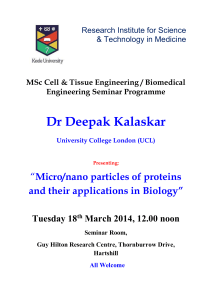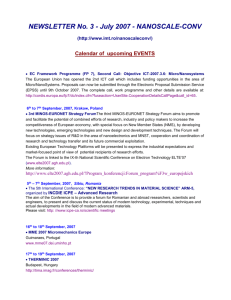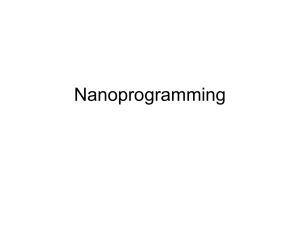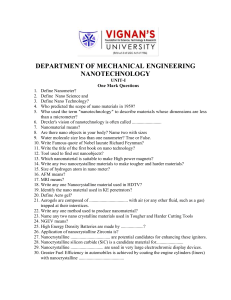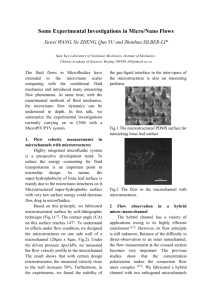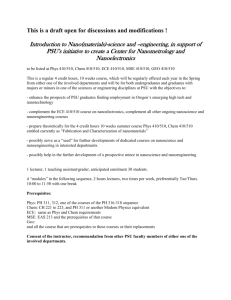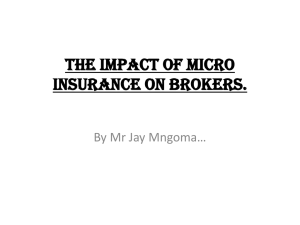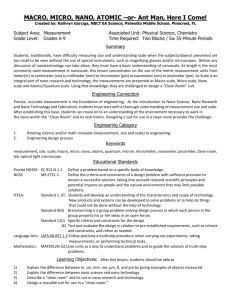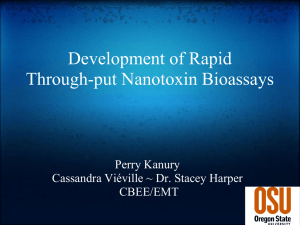presentation here - UCLA Mechanical and Aerospace Engineering
advertisement
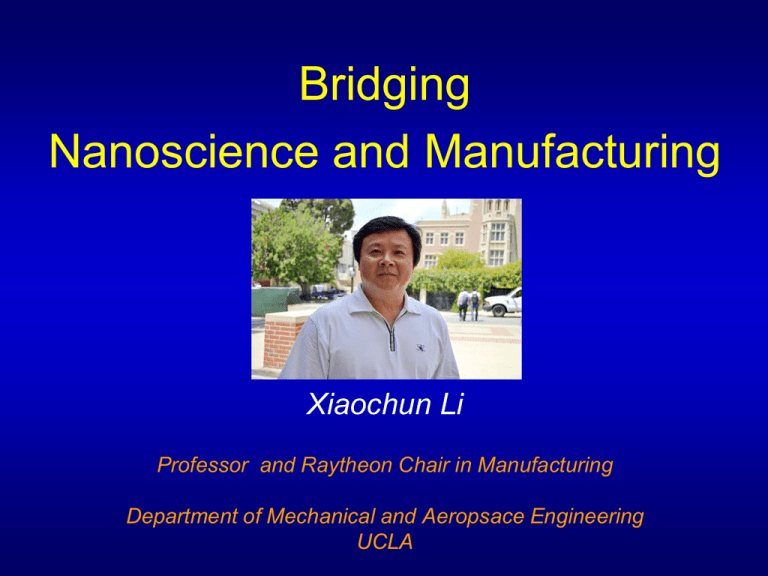
Bridging Nanoscience and Manufacturing Xiaochun Li Professor and Raytheon Chair in Manufacturing Department of Mechanical and Aeropsace Engineering UCLA Something about Xiaochun Li • Education 1992 Dual B.S. 1997 M.S. Mechanical Engineering and Applied Physics, Tsinghua University, China Industrial, Welding and System Engineering, Ohio State University Mechanical Engineering, Stanford University 2001 Ph.D. • Work experience – 2013-present – 2009-2013 – 2006-2009 – 2001-2006 Professor and Raytheon Chair in Manufacturing, MAE, UCLA Professor of Mechanical Engineering and of Materials Science Program, UW-Madison Associate Professor of Mechanical Engineering and of Materials Science Program, UW-Madison Assistant Professor, Department of Mechanical Engineering, University of Wisconsin-Madison Bridging Nanoscience and Manufacturing • Penetration of nanotechnology to practical systems/processes – Practical applications demand large scale processes • Numerous engineering systems and processes (e.g. manufacturing) operate in harsh environments • Scale up nanomanufacturing – – – – Economical production of nano-building blocks Control size distribution Dispersion and stabilization of nano-building blocks Large scale and controlled processing • Manufacturing engineers not well prepared – Unprecedented knowledge challenges for manufacturing engineers educated under traditional curriculum • Understanding and use of quantum phenomenon and intermolecular forces becomes essential – Manufacturing physicist/chemists needed? Two Active Research Directions • Scalable Nanomaterials Manufacturing – From nanoscience to nanoproduction of nanomaterials • Nanosystems Enhanced Manufacturing – Nano devices integrated into systems for advanced functionality and capability Metallic Nanomaterials • Important for widespread applications – Structural applications – Functional applications • Electrical, magnetic, catalysis… • Thermoelectric, energy generation, propulsion... • Semiconductor, solar… • Lightweight metallic nanomaterials (e.g. Al, Mg, Ti, TiAl) – Enhanced properties for lightweight materials • Significantly improve energy efficiency (e.g. for automotive and aerospace industries) • Reduce use of nonrenewable fuels and lower greenhouse gas emissions – Metallic nanocomposites for high temperature stabilities Solidification NanoProcessing From Nanoscience to Nanoproduction of Metallic Nanocomposites (Mg, Al, Ti, TiAl etc..) Nanoparticles and Molten Metal Nanoparticles Fabrication and Production 1. 2. 3. 4. Incorporation Mixing Dispersion ……. Solidification Nanoprocessing and Nanomanufacturing Thermomechanical Processing 1. 2. Heat treatment Extrusion/rolling …… Solidification of Metal Nanofluid 1. 2. 3. 4. 5. Particle pushing Particle capture Nucleation Grain Modification ……. Structurally Integrated Micro/Nano-Systems (SIMNS) • Design, fabrication, and embedding of micro/nano sensors for multi-scale manufacturing • Additive Manufacturing of “smart” tooling/components – Solid Freeform Fabrication or digital manufacturing – Direct print thin film electronics and sensors… • Micro/Nano sensors array for power and energy systems • Scaffold-Integrated micro/nano sensors and actuators for micro/nano-mechanobiology Challenges in Harsh Environments • Surface behavior dominance problematic in real world, especially in harsh environments – High temperature, high stress/pressure, electromagnetic interference, nuclear radiation, chemical , wear, corrosion (including biocorrosion) etc • Existing knowledge base on narrow material bases • Lack of basic understanding on behavior of micro/nano devices/components under harsh conditions Nanophotonic Manufacturing e.g. Sensor array e.g. Harsh Environments e.g. Nanoparticle Nano-wires Engine Biomedical Oil exploration Micro/Nano Sensors for Engineering • Continuous monitoring and control of thermal, mechanical, and biological responses in engineering systems • at or near interaction interface with unprecedented resolutions • Improved understanding of scientific fundamentals • Manufacturing, power/energy generation, oil exploration, biomedical… • Better product quality, higher productivity, lower cost
